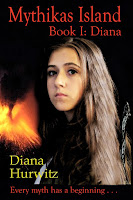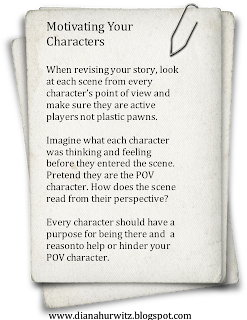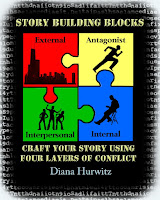Disunity obstacles motivate characters to offer resistance to, or agree to assist with, another character’s scene goal or overall story goal.
Motivating your primary characters is essential to a well-developed plot. Motivating your secondary characters, the friends and foes, adds depth.
1. Competition. Wishing to one-up, surpass, or defeat someone can be mild or taken to laughable, even deadly, lengths. The competition between characters can be out in the open. They know they are competing for the woman, the antiquity, the position, or the country. It can be an undercurrent that flows between two characters who aren't even aware this is their motivation.
2. Jealousy and resentment. How long has that pot been boiling? What causes it to overflow?3. Gossip, rumors, and backbiting. I am struck by how often characters exist in a bubble. They are part of the wider world. What they do and say will be observed, discussed, and perhaps acted upon.
4. Blackmail. Secrets are the lifeblood of good suspense. They do not have to be conspiracies or fatal. They only require that the character feels shame about something they don't want other people to know. Giving another character the power to expose them adds tension.
5. Differing goals and needs. This conflict can be mild or ruin a relationship, a heist team, or derail a war.
6. Dislike, hatred, or anger. Few character types are overt in their expression of these emotions. A subtle level can lead a friend or foe to fail to cooperate, break a promise, or cause them to undermine every goal your character has.
7. Love for something or someone. Love unites. However, love can prevent a character from taking an action that will hurt someone they care about. The threat can be deadly, but they will not risk it. Love can also motivate someone to go beyond normal limits and take uncharacteristic risks. It can provide the push to keep them moving toward their goal or add the resistance to doing what needs to be done.
8. Friendship and loyalty. Few characters are completely friendless or free of bonds of loyalty. Who are your characters beholden to? Who will they betray? What is the price of that betrayal? Who will they catch a grenade for?
9. Opposing methods of negotiating the world. Some are mavericks. Some are conservatives. Some are willing to do whatever they want regardless of the cost. For others, the cost is too dear. Putting opposites together heightens the tension. Every decision and action will create conflict.
10. Shallowness versus depth of connections. How easy is it for your character to walk away? What is the cost? Deepening their connections heightens the stakes.
Motivation drives each character in your story. They may know what motivates them. They may be completely unaware. The other characters may be aware or completely unaware of why characters behave as they do.
Tweet this: Motivation transforms your cardboard characters into flesh and bone.
For more about how to craft characters, pick up a copy of Story Building Blocks II: Crafting Believable Conflict, available in paperback and E-book and Story Building Blocks: Build A Cast Workbook, available in paperback and E-book.
Disunity obstacles motivate characters to offer resistance to, or agree to assist with, another character’s scene goal or overall story goal.
Motivating your primary characters is essential to a well-developed plot. Motivating your secondary characters, the friends and foes, adds depth.
1. Competition. Wishing to one-up, surpass, or defeat someone can be mild or taken to laughable, even deadly, lengths. The competition between characters can be out in the open. They know they are competing for the woman, the antiquity, the position, or the country. It can be an undercurrent that flows between two characters who aren't even aware this is their motivation.
2. Jealousy and resentment. How long has that pot been boiling? What causes it to overflow?
3. Gossip, rumors, and backbiting. I am struck by how often characters exist in a bubble. They are part of the wider world. What they do and say will be observed, discussed, and perhaps acted upon.
4. Blackmail. Secrets are the lifeblood of good suspense. They do not have to be conspiracies or fatal. They only require that the character feels shame about something they don't want other people to know. Giving another character the power to expose them adds tension.
5. Differing goals and needs. This conflict can be mild or ruin a relationship, a heist team, or derail a war.
6. Dislike, hatred, or anger. Few character types are overt in their expression of these emotions. A subtle level can lead a friend or foe to fail to cooperate, break a promise, or cause them to undermine every goal your character has.
7. Love for something or someone. Love unites. However, love can prevent a character from taking an action that will hurt someone they care about. The threat can be deadly, but they will not risk it. Love can also motivate someone to go beyond normal limits and take uncharacteristic risks. It can provide the push to keep them moving toward their goal or add the resistance to doing what needs to be done.
8. Friendship and loyalty. Few characters are completely friendless or free of bonds of loyalty. Who are your characters beholden to? Who will they betray? What is the price of that betrayal? Who will they catch a grenade for?
9. Opposing methods of negotiating the world. Some are mavericks. Some are conservatives. Some are willing to do whatever they want regardless of the cost. For others, the cost is too dear. Putting opposites together heightens the tension. Every decision and action will create conflict.
10. Shallowness versus depth of connections. How easy is it for your character to walk away? What is the cost? Deepening their connections heightens the stakes.
Motivation drives each character in your story. They may know what motivates them. They may be completely unaware. The other characters may be aware or completely unaware of why characters behave as they do.
Tweet this: Motivation transforms your cardboard characters into flesh and bone.
For more about how to craft characters, pick up a copy of Story Building Blocks II: Crafting Believable Conflict, available in paperback and E-book and Story Building Blocks: Build A Cast Workbook, available in paperback and E-book.
 |
16 Characters
|
Each mannequin could be male or female. I had to choose pronouns, so I went with the pronoun that matched the greater percentage of gender in each category. He and she can easily translate into masculine, feminine, or androgenous. Sex and sexual orientation do not directly affect personality type, except when it comes to social expectations and how those expectations shape the character.
Everyone has deep-seated needs that serve as currency: the thing that defines their personal carrot and stick. Dangle the right morsel in front of them and they will do anything to get it. Threaten to take it away and they will do anything to keep it.
1. Wynn’s currency is appreciation. She is the worker bee, never the queen. She needs to be needed, to hear “well done” often, and to be thanked for the everyday things she does to keep a life, a workplace, or a planet running smoothly. Telling her that her help isn’t needed or wanted is her trigger.
2. Francis is more interested in being right than being happy. He sees himself as the herd dog keeping everyone in line. He needs people to respect his authority and opinions. All is well, as long as people accede to his point of view and decisions. Call him wrong or question his authority and the fight is on.
3. Nevada hates conflict. He sees himself as the shepherd who guides the flock. His currency is appreciation for his dedication to others. He craves loving affirmations for working hard and providing for other people. Calling him selfish or telling him his efforts are misguided starts a fire.
4. Arden’s currency is gratitude and appreciation for his integrity. As long as people respect him and appreciate his hard work, things go smoothly. Tell him his assistance isn’t needed or question his intentions and the game is on.
5. Blair’s currency is affection and admiration. If she isn’t consistently praised, she deflates. Telling her she is anything but perfection or that she hasn't done anything to earn praise makes her an enemy.
6. Dallas wants to be adored for being the life of the party. She values her sense of fun and adventure. Telling her the party is over or to get serious and she will make your life hell.
7. Hadley wants to be adored for breathing. She wants everyone to be happy. Since she is generally agreeable and good-natured, people usually comply. If the adoration fades, trouble sets in.
8. Shelby wants to be honored and respected. She is a team player. As long as people treat her like a valued member of the team, family, or planet, things are fine. Questioning her character is a call to war.
9. Joss craves recognition for his intelligence and skill. He's the typical silent maverick. He is usually admired in the short-term. His derring-do draws people in, but eventually drives them off. Question his competence and you’ll like find yourself in the crosshairs of his sniper scope.
10. To Kelly, all the world is a stage and he is the main attraction. He is the ultimate game player and always wins. Never accuse him of being a loser or make him sit on the sidelines.
11. Greer is the ultimate reclusive genius. He wants recognition for his competence. Since he is usually competent, he receives it. When he forgets to take care of things he does not consider important or his efforts are misdirected, his competence might be questioned and the fight is on.
12. Taylor is the ultimate organizer or volunteer. She wants to be appreciated for her goodness and service. She usually is, unless her efforts become toxic.
13. Cam wants to be admired for his intelligence and competence. He is the deep thinker of the group. People usually admire that about him. Question his competence or his research and the fight is on.
14. Morgan also wants to be admired for his intelligence and competence. He is the ultimate thrill-seeking gambler. When his sometimes reckless behavior makes those traits questionable, the game is afoot.
15. Lee is the take control steamroller of the group. Lee wants to be top dog. Things are fine as long as her rules are obeyed. When she steamrolls the wrong person or is demoted, she turns lethal.
16. River is the most spiritual and likely to believe in the paranormal. She wants to be admired for her wisdom and desire for harmony. She is usually admired, unless her desire to be worshipped becomes obsessive or her belief system is too bizarre.
To learn more about the mannequins and how personality types create conflict for your characters, pick up a copy of Story Building Blocks II: Crafting Believable Conflict, available in paperback and E-book, and Story Building Blocks: Build A Cast Workbook available in paperback and E-book.
As I turn 53 today, several recent events converged to make me examine why I write and whether I want to continue writing.
I wrote and published 8 books between 2007 and 2012. I have not written a book in a while and Create Space sent me an email asking if I was still writing.
I had lunch with a friend and we talked about my dry spell and she asked me what would make me passionate about writing again. I have suffered health crisis after health crisis since before I wrote Mythikas Island, which has resulted in a roller coaster of frenzied work and months living as a cat. Health woes certainly contribute to the ambivalence. I began writing poetry and journaling as a young girl. I did not attempt fiction until I was middle-aged. So as I explored the reasons why I started writing books in the first place, a theme developed.
 I wrote the Mythikas Island series (I: Diana, II: Persephone, III: Aphrodite, and IV: Athena) for my daughter Anna. She was a teenager and was sick of love triangles in YA books. She said some girls wanted stories that didn’t revolve around guys. Ideas for stories about goddesses and girl power had been percolating for a while and that became the impetus for the Mythikas Island series. Four girls are groomed to be leaders and must save themselves and fight for their future.
I wrote the Mythikas Island series (I: Diana, II: Persephone, III: Aphrodite, and IV: Athena) for my daughter Anna. She was a teenager and was sick of love triangles in YA books. She said some girls wanted stories that didn’t revolve around guys. Ideas for stories about goddesses and girl power had been percolating for a while and that became the impetus for the Mythikas Island series. Four girls are groomed to be leaders and must save themselves and fight for their future.
I wrote the Story Building Blocks (I: The Four Layers of Conflict, II: Crafting Believable Conflict, III: The Revision Layers, IV: Build A Cast Workbook) because I couldn’t find them anywhere when I needed them. I was tired of reading about the story arc and all those motivational tomes. I wanted nuts and bolts and tools for developing plots and characters. I wanted advanced craft lessons. I also wanted to centralize all of my notes on revision, editing, and proofreading. So, I spent several years learning, reading, dissecting stories, and researching. I developed a story architecture theory that made sense to me. This blog, Game On, is an extension of the desire to share what I learn. I also guest post on The Blood Red Pencil, another blog devoted to the craft of writing.
I have studied interior formatting, cover design, and website building. Although far from expert, I have added those skills to my tool kit.
Then I was blindsided with the misdiagnosis of a mystery muscle disease. That led to a year of research and another year of developing that research into a website for the rare disease, Stiff Person Syndrome, which became The Tin Man. It not only has up-to-date information on SPS, but a large section on how to cope with debilitating diseases and resources for patients with rare diseases. Again, things I couldn't find that I needed.
While I haven’t been entirely slothful, there was no book at the end of those two-plus years. Create Space had no way of knowing that, hence the gentle reminder.It turns out, I am motivated by writing things that benefit other people. It is the sharing information and helping that bring me joy. If I inspired one teenager, helped one writer, or educated one patient, I consider all that time well spent.
I’ve always joked to my critique group that my biggest problem is that I don’t need the money and I don’t want to be famous. I admit to being turned off by the business and promotional aspect of publishing, as necessary as it is to being a lucrative independent author. It is an area I would need to research and I’d have to overcome my natural resistance to being in the spotlight and sales promotion. I would also have to work around my physical limitations. I’d much rather sit in a room churning out work and let others worry about what to do with the end product. Alas, successful writer-preneurs are not built that way. So, I have to decide if that is the way I want to spend time.
I attended a funeral yesterday for a friend that made me ponder what I want to do with my remaining time. He died during the adventure of a lifetime, checking off a big item on his bucket list. This led me to examine what I am still capable of and prioritizing my bucket list.
The hubs is going to retire next year in August. After our relocation from Windyana to Adult Disneyland, I don’t know what my days will be like. All those long hours I spent working or sleeping while he was at the hospital will now be filled with different things.
My muses still visit and my characters still chime in with ideas of where they'd like to go, especially my goddess girls. I have more ideas for the Story Building Blocks series. I have a draft of a YA story, and first chapters of many others that I call my Widows & Orphans file including a mystery called The Wicked Stage.
But will they ever see print? Who knows? Once the reno nightmare of the new house and trauma of moving are over, I may put fingers back to keyboard. If for no other reason than to free the characters that haunt me like trapped ghosts seeking the light.






